Beyond the appeal of their lustrous surfaces and glowing colours, pieces of Himalayan jewellery have the power to reveal intimate facets of the lives of those who owned and wore them. Like a tiny mirror reflecting a society often distant in time and space, a single piece can reveal its wearer’s sex, their regional origins, position in society and way of life as well as allowing us glimpses of religious preoccupations and beliefs.[1]
The perag (padrag) is possibly Ladakh’s most widely-known and recognisable piece of jewellery. It is also one of the most enduring symbols of Ladakhi women, their heads covered by a long tapering band of lines of turquoise (yu) interspersed with silver and gold pendants, coral and pearls. (Fig. 1) While it is difficult to trace the origin of the perag, it has been suggested that the headdress was introduced to Ladakh by one of the queens and subsequently replaced earlier forms of female head coverings.[2] Visuals of the perag, while not present in the murals at Alchi, are apparent in the sixteenth-century frescos of the Tsemo Temple at Leh and at Basgo monastery.[3]
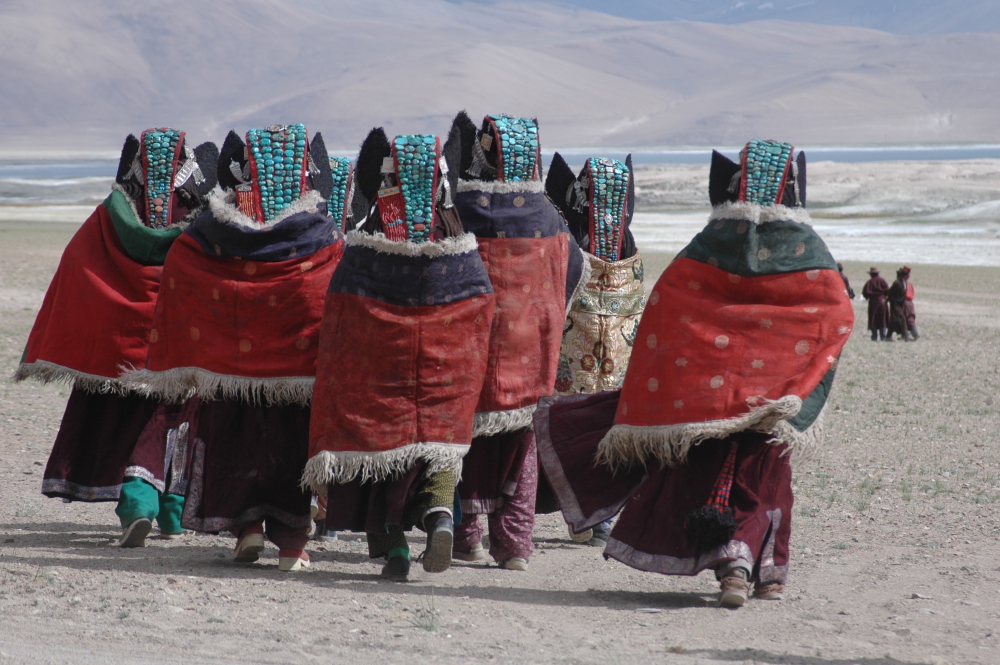
The perag, literally meaning ‘lotus cover’, has many regional variations in Ladakh.[4] The type of perag currently worn in central Ladakh is the most popular variety. It consists of a tapering base of leather covered with red felt or cotton onto which turquoise pieces are stitched in vertical lines. The design begins with a single large turquoise stone over the woman’s forehead, which is said to take the shape of a serpent’s hood, as it fans out into several lines of turquoise, tapering midway down her back. Silver or gold amulet boxes (ga’u) with semiprecious stones are placed along with the turquoise lines. Women who can afford it attach a separate segment of cloth (chuti) to the left side of the perag, and on to this stitch up to ten vertical lines of coral (churu) ending in cowrie shells. The perag is fastened over a hairpiece (lambu) consisting of woollen braids tied along with braids made of the wearer’s hair and gathered together at the bottom with a large yarn tassel (geblin) made from wool, coins, cowrie shells and small brass bells. On either side of the perag are earflaps (naglan) made from black lambskin (tsaru); they are said to have been introduced by a queen who had an earache. Before the trade routes closed, royalty used sable from Yarkand for the earflaps, as well as astrakhan (lambskin) from the Karakul sheep or brown otter skin. Now, with growing awareness of animal rights, earflaps made from synthetic materials have come into use. Holding the perag and earflaps in place are silver chains (thenthak). Below the silver chains hang flat silver plaques (shunga), usually with a knot motif, from which dangle small bells.
Variations in the perag include shape, nomenclature, accessories, the number of turquoise lines and presence of added coral strip on one side. In the Sham area in lower Ladakh, women were the yudan (turquoise spread), which is similar to the perag. In the north and eastern regions of Ladakh, known as Changthang, and inhabited by nomadic pastoralists, women wear the garleb. This has a long flat piece of silver above the forehead rather than the single large turquoise. (Fig. 2)
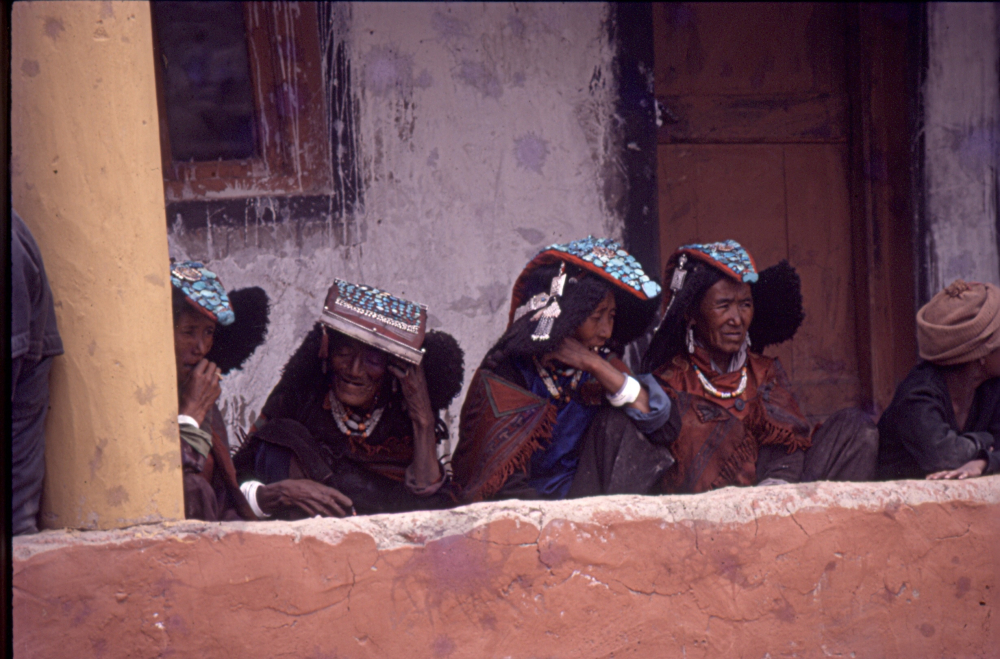
In the Wakha-Mulbekh area in western Ladakh, women wear a jewel-studded cap to which is attached a turquoise-lined tail, much shorter than the one on a central Ladakhi perag.[5] In Turtuk, and neighbouring villages predominantly inhabited by Muslims, women wear a silver tiara (ngama chaneyetu) on their head. (Fig. 3) It is attached to a red cloth that sits on her head like a fitted cap and tapers down her back to end at a pointed edge (the shape similar to that of the perag).[6]

On her left shoulder, a Ladakhi woman wears a chatelaine (tsundus), and from the belt around her waist, she hangs one or a pair of dodchas—a silver or brass disc usually bearing the endless knot of good fortune, from which six or seven lines of cowrie shells are strung with little bells at the end. Her earrings (a-long) can take different shapes—one consists of a lotus flower with turquoise petals from which several strands of pearls (mutig) dangle, another is made of several strings of freshwater pearls attached to a metal hoop whose weight is supported by chains. (Fig. 4)

Around her neck she wears one, two or three necklaces (skecha). One is typically an amulet, usually octagonal in shape, made from silver or gold (or gold plated) and set with turquoise, coral or aniline stones, hung on a string of pearls. It may also be decorated with filigree work. A second necklace may be of large coral, amber and dzi (etched agate) beads. A third may consist of a series of small silver amulets, oval in shape and joined together by a strand of small coral beads. (Fig. 5) The fashion of wearing multiple strands of necklaces can be traced to the fourteenth century or earlier, as depicted in the murals at Alchi, and probably reflects the influence of north Indian designs. An example is the type of necklace that combines two strings of coral beads with silver spacers and a fringe of drops. Upper-class women also wear a gorget, a stiff collar piece (skebug) made from a piece of padded red cloth onto which a large central gold or silver amulet piece is stitched, along with lines of coral and silver beads. (See fig. 14). A fringe of silver amulet pieces may be stitched on the lower end.
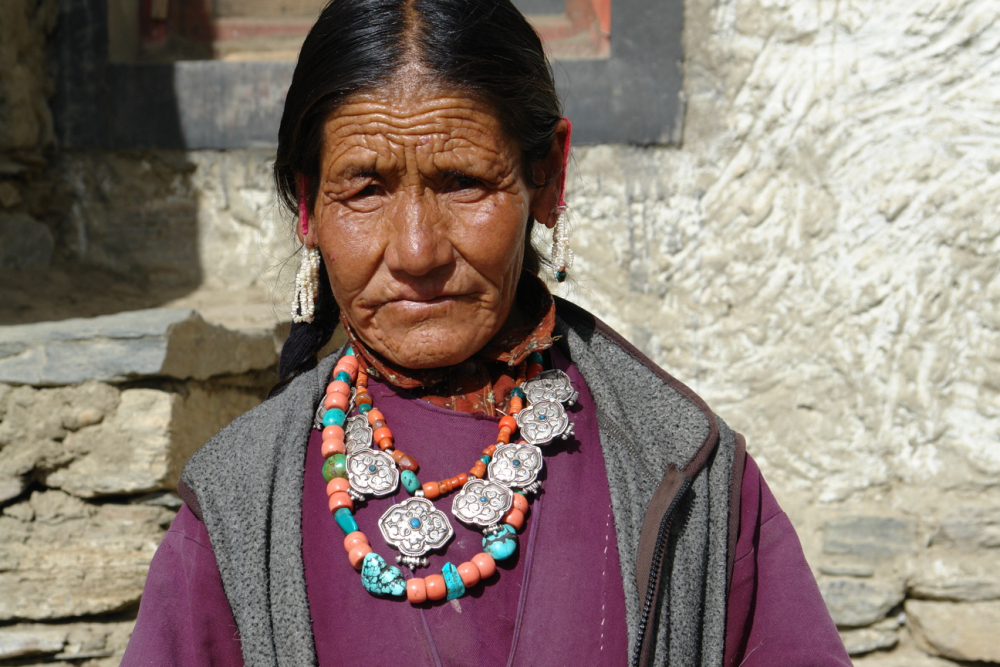
Around her wrists she wears a pair of conch-shell bracelets (tunglak); these are placed on the wrists of a young girl and cut off and replaced when she outgrows them. A woman normally wears these bracelets throughout her life. Silver bracelets, similar in shape to the conch-shell ones, are worn by wealthier women. Those worn by Buddhist women are embossed with patterns of religious symbols, while Muslim women wear versions embossed with geometric designs. (See fig. 14). Women also wear narrow silver bracelets, the ends meeting as two dragons or makara heads, with turquoise stones embedded for the eyes.
The perag identifies women with the klu, spirits that inhabit the aquatic and subterranean worlds and are associated with the feminine form and fertility, as the lines of blue turquoise running down women’s backs in a tapering fashion are said to resemble the body of the klu. Married Buddhist women were once required to wear their headdresses at all public occasions, especially during visits to monasteries and during the summer months, from the time the fields were green until the end of the harvest.[7] Nomadic women would don their perags when they sat at their looms or moved camp. (Fig. 6)
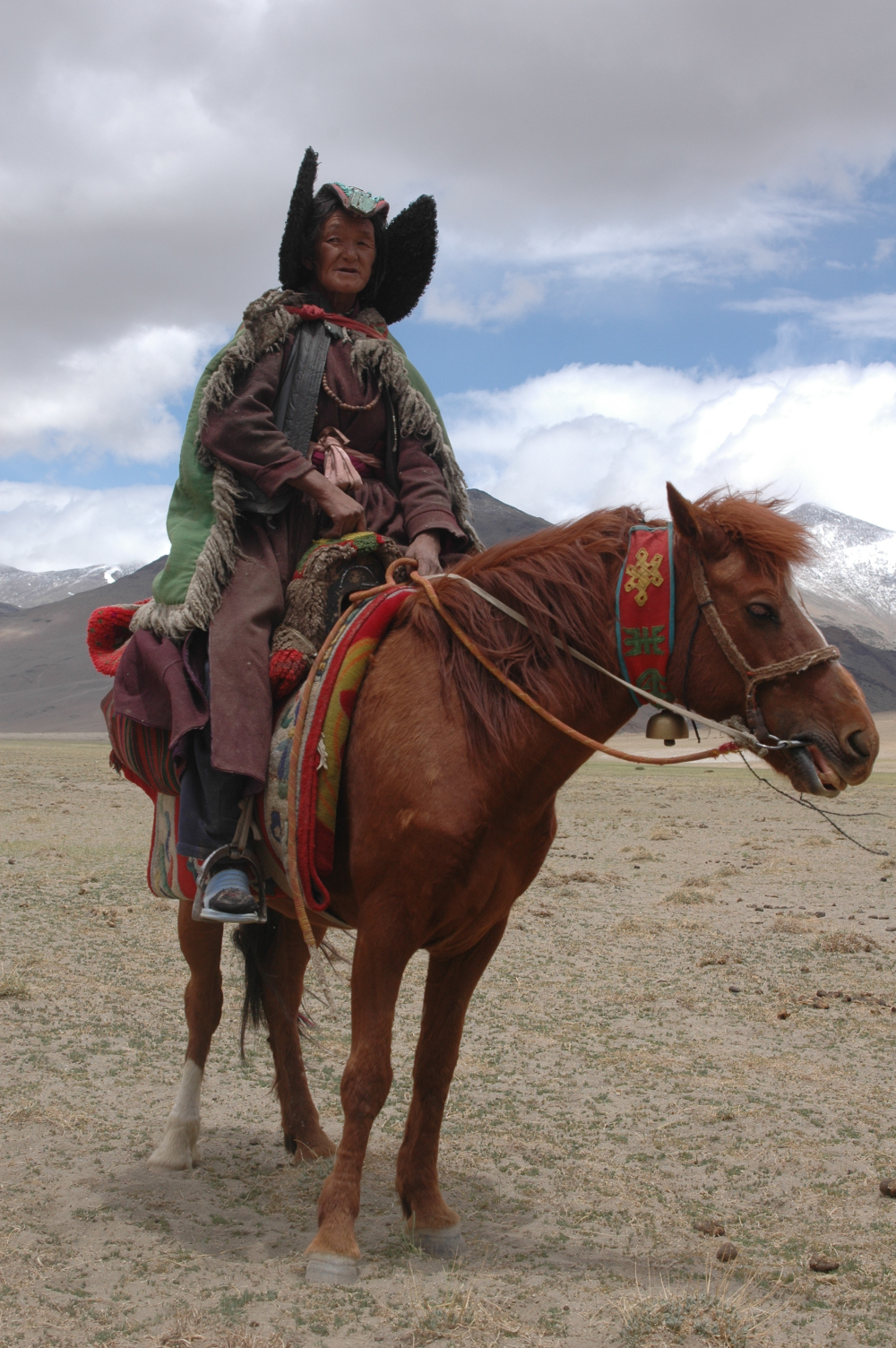
Perags were essentially women’s heirlooms, passed down from mother to eldest daughter. New perags, usually smaller in size, were made for younger daughters. The only exception is the perag belonging to the royal family of Ladakh, which is inherited by the queen’s daughter-in-law, the future queen, and so stays within the family. (Fig. 7) Perags are essentially portable assets that demonstrate a woman’s economic power and rank; a headdress with seven lines of turquoise was viewed as a status symbol in the town of Leh, while one with even five rows was admired in outlying villages.[8] Queens generally wore nine-line perags.
In some parts of Kargil district and amongst Muslim women in Leh, the perag was worn as late as the 1980s. It has since been replaced by the jhugni, a head ornament similar to the Indian jhumar, a half-crescent-shaped gold piece inlaid with turquoise or carnelian stones with drop pearls. (Fig. 8) The jhugni is worn only at weddings, along with a white veil covering women’s heads but not their faces. According to residents in Leh, Christian women wore the perag until the 1960s.[9]

Men in Ladakh, mainly the Buddhists, wear jewellery consisting of single earrings, and necklaces similar to women’s, though the amulet boxes are larger. (See fig. 7) They also wear necklaces of large coral, turquoise and dzi stones. (See fig. 14) In their left ear they wear a hooped earring made of a circle of pearled wire set with a single turquoise stone facing outward. They may wear silver or copper ga’us in a variety of shapes—square, rectangular, hexagonal and lozenge. Men also wear embossed amulet boxes made from silver, copper or brass, tied across the back for protection and to ward off evil spirits and demons. These serve as temporary shrines while on long journeys, and contain prayers or small figures of Buddha. They are usually decorated with the eight auspicious emblems and other symbols of Buddhism. Men also wear a single turquoise stone on a silk cord around their neck. They also wear silver or gold rings (serdup) set with a single turquoise or coral stone. These may be round in shape but the more popular ones, fashionable with the influence of Tibetan design since the 1960s, are said to resemble a horse’s saddle (stagam). From the belt around their robe they hang an assortment of beautifully crafted utility objects such as a knife, spoon, needle case and a flint in an ornate purse. (Fig. 9)

Brogpa women wear necklaces and shoulder pieces similar to those worn by other women in Ladakh, but they do not wear the perag. Instead, both men and women Brogpas wear elaborate hats: the base is made from woollen cloth (snambu), and the surface is covered with silver coins, needles, flowers, plastic and brass buttons. The Brogpas say that the entire surface of the hat should be covered because that is auspicious; if even a little bit of the underlying fabric shows through, it can bring misfortune to the wearer.
Children in Ladakh, amongst both Buddhist and Muslim communities, wear amulet boxes for protection or to ward away the evil eye. (Fig. 10) Some of them may wear a single stone of turquoise around their necks, or a few coral and turquoise stones strung along with pearls. While in most parts of Ladakh the perag is given to women at the time of their marriage, in Changthang, young girls receive it prior to marriage, when they are 16 or 17 years old.

Ladakhi jewellers are called goldsmiths (gsermgar or gsermkhan), and most of them have small workshops in the towns of Leh and Kargil. Here they work, along with their apprentices, taking orders from parents of aspiring brides, many of whom travel long distances to meet their obligations. (Fig. 11) Prospective clients often bring their own stones with them, and sometimes also gold and silver to be melted down. Trade brought many precious and semi-precious stones to Ladakh, as well as metals such as gold and silver. Coral came from South India and the Mediterranean, mainly Italy, turquoise and gold from Tibet, gold and silver as well as semi-precious stones from India. Turquoise also came from Iran, amber from northern Europe and Burma, pearls from the Persian Gulf and conch shells from South-East India.
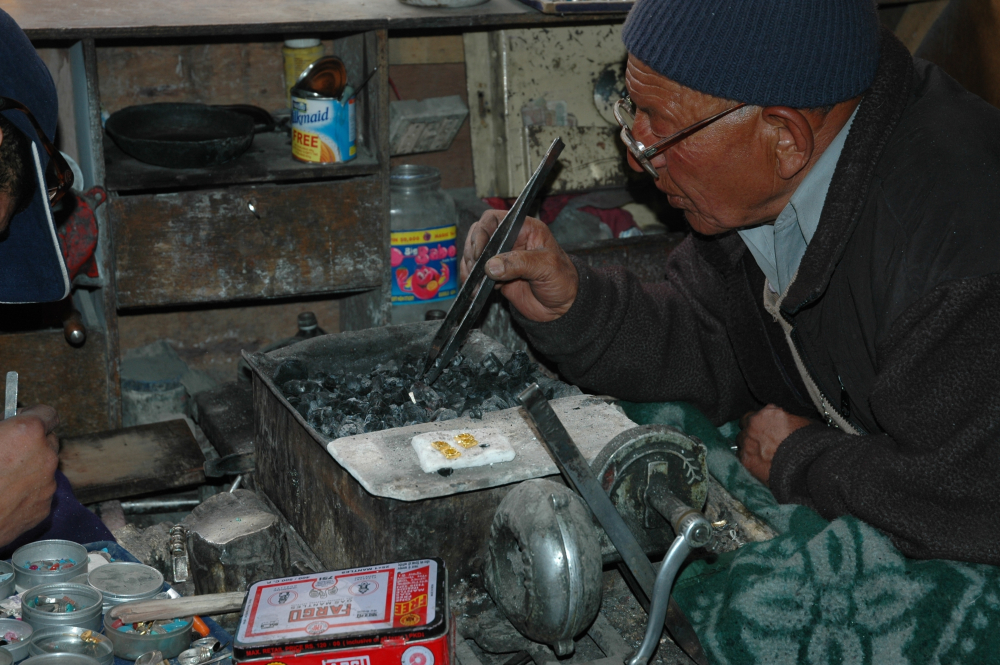
Jewels recur in Tibetan and Ladakhi belief systems as objects that fulfil material wishes, as offerings for the propitiation of deities and as abstract metaphors for the Buddha, Dharma and Sangha.[10] Along with textiles in monasteries, jewellery indicated offerings to the deity, creating an atmosphere charged with blessing and power of protective qualities.[11] It is also common for jewellery pieces to be donated to monasteries, more often on the demise of women. This is believed to ensure her a good future birth, and bring merit and peace to the departing soul. There are strong beliefs in the protective power of stones—to shield their wearers from harm and in their medical potency against certain diseases.[12] For instance, the dzi is said to protect the wearer from the attacks of evil spirits who can cause sickness and death.[13] Turquoise is said to purify the blood, remove poison, jaundice and diseases of heat affecting the liver.[14] Another belief is that when a turquoise changes colour from blue to pale green it indicates that the wearer has an illness. Coral is regarded as lucky, bring power to women, strengthen their blood and aid menstruation. Similarly, pearls are valued for enhancing women’s fertility.
Since the 1980s, trends in jewellery have also changed in Ladakh. The demand for modern Indian and Western jewellery is currently prevalent. Women no longer wear the perag while working in the fields, nor do nomadic women when moving camp or weaving. Instead women tend to wear the perag for special occasions, particularly religious festivals, more because it is expected of them than out of choice. Brides continue to wear the perag, but the other women attending the wedding rarely don the headdress. The perag is now more than ever associated with cultural identity in Ladakh, worn at public events, performances and to receive revered guests. Over the years, many perags and other forms of Ladakhi jewellery have also found their way to the antique market in Leh, where they are sold to collectors and interested tourists. (Fig. 12)

Jewellers continue to make some traditional items, mostly women’s gold filigree amulets in octagonal shapes, the newer butterfly pendant designs are also popular. Since the trade routes closed, first in the 1940s and then 1960s, imitation turquoise and other stones now come from Jaipur, and cultured pearls from Hyderabad. Tibetan traders who now come to Leh in the summer mainly sell new Indian or Nepalese jewellery to the local population and tourists. (Fig. 13) However, old stones still circulate, fetching exorbitant prices because of their intrinsic cultural, rather than strictly monetary, value. This is especially true for coral and dzi, which are worn with pride.

Since 2010, Ladakh has witnessed the emergence of several fashion designers, many of whom have studied the subject outside the region. Returning to Ladakh, they work with traditional form but are also inspired by a new vocabulary for design. They have gradually created a market, especially among the youth, that takes pride in wearing Ladakhi dress and jewellery. (Fig. 14) It is this impetus that will ensure jewellery in Ladakh will continue to endure and innovate.

Notes
[1] Clarke, Jewellery of Tibet and the Himalayas, 15.
[2] (Heber and Heber, In Himalayan Tibet and Ladakh, 126.
[3] Both these temples are connected to Ladakh’s royal family – Tsemo lies just above the palace in Leh and Basgo was the summer capital of the Namgyal dynasty. The scenes painted on the walls at Basgo for instance, show women (and men) richly dressed, wearing perags and other forms of jewellery.
[4] Aggarwal, ‘The Turquoise Headdress of Ladakh,’ 57; Untracht writes that the word ‘perag’ is said to be derived from the word per, an old Ladakhi term for turquoise, see Untracht, Traditional Jewellery of India, 129.
[5] Untracht, Traditional Jewellery of India, 129.
[6] It seems only older women (generally those over 50 years) wear the silver tiara like headdress, communication by email, Rigzin Chodon, 26.6.2020.
[7] Aggarwal, ‘The Turquoise Headdress of Ladakh,’ 62.
[8] Aggarwal, ‘The Turquoise Headdress of Ladakh,’ 62.
[9] Aggarwal, ‘The Turquoise Headdress of Ladakh,’ 64.
[10] Yeshi, Precious Jewels of Tibet,’ 65–83.
[11] Kalantri and Gyalpo, ‘On ornament, textiles and baldachins,’ 28.
[12] Stones are ground up by local doctors to form one of the ingredients in large pills called ril-bu. Clarke, Jewellery of Tibet and the Himalayas, 28.
[13] Clarke, Jewellery of Tibet and the Himalayas, 28.
[14] Clarke, Jewellery of Tibet and the Himalayas, 30.
Bibliography
Aggarwal, Ravina. ‘The Turquoise Headdress of Ladakh.’ In Ladakh - Culture at the Crossroads, edited by M Ahmed and C Harris. Mumbai: Marg Publications, 2005.
Ahmed, Monisha. ‘Ladakh.’ In The Berg Encyclopaedia of World Dress and Fashion – South Asia, Vol.4, edited by Jasleen Dhamija. Oxford: Berg publishers, 2010.
Clarke, John. Jewellery of Tibet and the Himalayas. London: V&A Publications, 2004.
Heber, A Reeve, and Kathleen Heber. In Himalayan Tibet and Ladakh. New Delhi: Ess Ess Publications, 1903.
Kalantari, Christiane, and Tsering Gyalpo. ‘On ornament, textiles and baldachins depicted on the ceilings of Buddhist cave temples in Khartse Valley, Western Tibet. Form, Function and Meaning.’ Kunstgeschichte. Open Peer Reviewed Journal 2011.
Untracht, Oppi. Traditional Jewellery of India. London: Thames and Husdon, 1997.
Yeshi, Kim, Roseanna Pugh, and Emily Phipps. ‘Precious Jewels of Tibet.’ In Choyang: The Voice of Tibetan Religion and Culture 1993.











